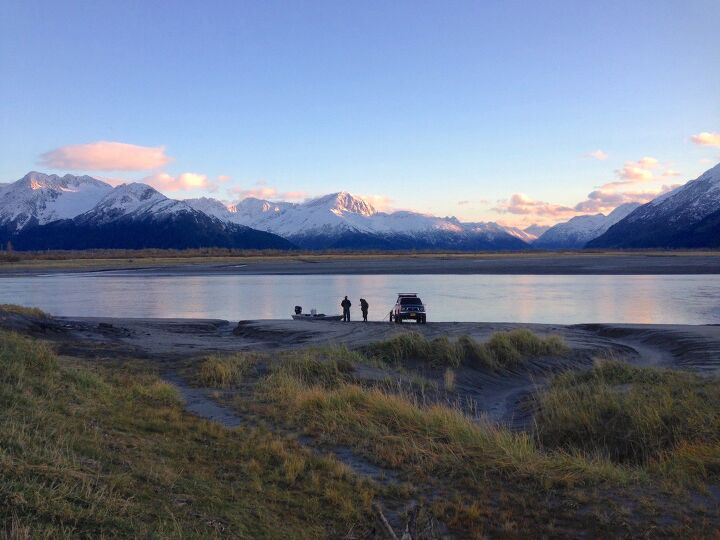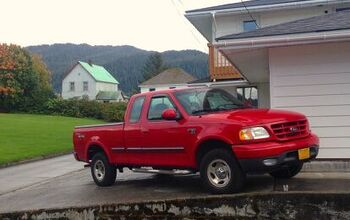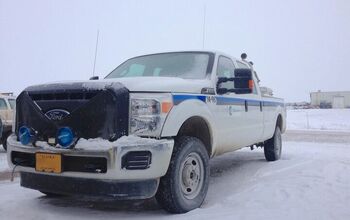U.S. North to South 2015: Anchorage, Alaska
After Barrow and Prudhoe Bay in Alaska, at the extreme north of the United States, we now fly south 620 miles (1,007 km) to Anchorage, the largest city in Alaska but not its capital.
As much as I would have liked to tackle the mighty Dalton Highway, an additional 230 miles and a 14- to 18-hour trip depending on the weather, time and budget constraints meant I had to fly instead, in a semi-cargo plane: the first third of the plane was cargo with the remaining two-thirds for passengers and entry only from the back of the plane. It was the first time I saw such a plane.
On the way, the bonus is sublime panoramas of the former Mt. McKinley, the highest summit in the whole of the United States at 20,320 feet high. Denali, the Indian name for the peak, appropriately means “The Great One”.
Along the Seward Highway, south of Anchorage
With just over 300,000 inhabitants, Anchorage accounts for 41 percent of the total population of Alaska: only New York City has a larger percentage of residents of the state it is located in (8.5 out of 19.7 million or 43 percent). Anchorage beats New York City when counting the Anchorage metropolitan area which represents 54 percent of the state’s population, and the “railbelt” between Anchorage and Fairbanks at the geographical centre of Alaska contains no less than two-thirds of Alaska’s population. Accordingly, there have been numerous attempts to move Alaska’s state capital from Juneau in the Southeast panhandle to Anchorage or a city closer to it, and all have failed so far.
After rejecting attempts to move the capital in 1960 and 1962, in 1974 the Alaskan electorate approved the relocation of the capital city to Willow, north of Anchorage, but later rejected it when faced with a $1 billion bill. Another plan to move the capital to Wasilla was rejected in 1994 as well as a plan to move the legislature to the Mat-Su Borough in 2002. Interestingly, however, Anchorage houses twice as many state employees as Juneau, making it the unofficial centre of state and federal government activity in Alaska.
The last bit of trivia on Anchorage is the one that intrigued me the most. Contrary to the perception of being a totally isolated city, Anchorage is within less than 10 hours by air to roughly 90 percent of the industrialized world. As such, it is a critical refuelling stop for many airlines and home to a major FedEx hub. The furthest main U.S. airport from Anchorage is Miami (4,005 miles/6,445 km), and here is where it becomes interesting: Beijing, China is closer at 3,979 miles (6,404 km), while Moscow, Russia (4,362 miles/7,020 km) and London, England (4,488 miles/7,223 km) are only a tad further.
Due to Anchorage’s overbearing demographic weight within the state, the best-selling cars here are defining the Alaskan ranking as a whole. You can find Alaskan sales figures by model for the first 6 months of 2015 here. The five most popular vehicles in Alaska are all trucks, with a surprise overall leader: the Ram Pickup, distancing the Chevy Silverado and Ford F-150, GMC Sierra and Subaru Forester. The best-selling passenger car is another surprise: the Subaru Outback, whereas it only ranks 33rd nationally so far in 2015. This is the start of a continuous home run all through the north-west of the country by Subaru, as I will detail in this series. The Outback outsells the Chrysler 200, the Toyota Camry, Dodge Charger and Chevy Cruze. The detailed sales figures are here.
Coming from the Arctic Ocean, the vicious rain and wind that welcomed me in Anchorage almost seemed mild. Downtown Anchorage has a double personality: during bad weather it seems like a city of big, bland and grey buildings, but when the sun comes out, suddenly a myriad of cute little wooden houses seem to appear out of nowhere. Giant Arctic-themed murals brighten up the town in any case. Friendly residents seem to be convinced you have to be insane to live in Anchorage, and even more insane to travel from Sydney, Australia to come here and enjoy the … cold? Unpretentious and curious would best describe Anchoragites (that is the correct demonym), and they know how to deliver a succulent halibut burger at Humpy’s Great Alaskan Alehouse. I had all my dinners there.
How does the Anchorage car landscape reflect Alaskan sales? Full-size pickups rule here, and mid-size ones such as the Toyota Tacoma or Nissan Frontier are sparse. When Anchorites buy pickup trucks, they mean it: I spotted a very high ratio of spruced up, elevated and big-footed full-size pickups here. Rams and Chevys are indeed more frequent than Fords, and I fittingly only managed to spot one new generation F-150 in the three days I spent in town. That’s as many F-150s as in two hours in Prudhoe Bay! The GMC Sierra is clearly outperforming its national performance here in Alaska, and we’ll have official confirmation of this shortly at the Anchorage GM dealership.
There is a clear and strong Subaru heritage in Anchorage, including a rare Baja pickup, but the majority are starting to age even though the Outback is indeed the most frequent new passenger car downtown. The Toyota Camry justifies its third position in the Alaskan passenger car ranking with a solid presence of the new generation already, while we will need to drive out of Anchorage into the touristy fjords to understand the particularly high rankings of the Chrysler 200 and Dodge Charger in Alaska. I also spotted the first Mazda CX-3 of this trip as well as the first new-generatuon Volvo XC90.
The GM dealership in Anchorage displays a handful of Chevrolet Silverados with snowplows already pre-fitted! That’s a first, as far as I am concerned. I had to have a chat with someone there.
George LaMoureaux from GM Anchorage
And what a character I met! George LaMoureaux, Sales Consultant at “the largest General Motors dealership in the north-east”, is an advanced mountaineer who has climbed neighbouring Mt. McKinley/Denali and … Mt. Everest!
LaMoureaux estimates that roughly 70 percent of new vehicles sold in the dealership are light trucks — well above the 55-percent national average — and, confirming the sales figures and my observations above, the GMC Sierra over-performs with a 35-65 Sierra-Silverado sales ratio instead of 27-73 nationally so far in 2015.
According to LaMoureaux, the Sierra and Silverado are interchangeable in the eyes of customers: if they find a model, finish or equipment in the lot that is what they need, they will drive out of the store in a Sierra even if they came in wanting to buy a Silverado, and vice-versa. This would mean there is very little brand loyalty to GMC and Chevrolet and more so to General Motors brands as a whole, a rather interesting find as far as I am concerned as the dual-branding strategy General Motors is using has always intrigued me. Positioning GMC as both premium and industrial is an oxymoron but it enables GM to hit price points with the Sierra that it wouldn’t be able to with the Chevrolet brand. Yet, with the GM full-size pickups outselling the Ford F-Series in the U.S. every month this year, this dual-brand strategy means GM is missing out on the title of best-selling vehicle in the U.S. Is it worth it?
On the subject of mid-size pickups, which surprised me by their rarity in town, I saw just two Chevy Colorados on the lot and no more than eight GMC Canyons. LaMoureaux affirms there isn’t enough stock to meet a very significant, pent-up demand that has accumulated during the two years these nameplates were discontinued. Given I have seen no new Colorado nor Canyon models in the streets of Anchorage, whereas I saw some further downstate where the population is much smaller, I would beg to differ. I drove a $41,540 GMC Canyon whose cabin didn’t feel smaller than the Ram 1500 I drove last year. A refined interior and very solid boost at kick off would have been the perfect companions for our explorations outside Anchorage. Unfortunately, I visited the GM dealership at the end of my stay here and my ride was a puny Ford Fiesta. Gotta try everything that’s available, right?
If you are thinking of visiting Anchorage, its surroundings are a lot more interesting than the city itself, so it is a must to escape the city.
North towards Fairbanks led me to rainy, sleepy and friendly Talkeetna, and eerie Eklutna Lake where I got to chat with a moose hunter/army officer that had just been in the wild for a full week. There, the 1987 Ford F-Series still dominates the vehicle landscape. The journey southbound from Anchorage on the Seward Highway is an uninterrupted panorama of snow-capped mountains, glaciers breaking into icebergs onto the sea, and picturesque fishing villages ending on the posh town of Seward. I have travelled a fair bit in my life but never before have I seen such a mesmerizing succession of unbelievably beautiful landscapes. Everywhere you looked could be the main picture of an annual calendar. And this is where I spotted a thick flow of Chrysler 200s, meaning its #2 ranking in Alaska is almost entirely due to sales to rental companies. It goes the same for the Dodge Charger.
On both these journeys I drove Ford Fiesta sedans. In fact, two different ones that each had their nagging defaults. The first, older one has a central console that features so many buttons that it’s a lot safer to just ignore everything and concentrate on the road. The second one — slightly more recent — had fixed the central console issue by replacing all the buttons with a touchscreen that was as confusing as the now-gone buttons. Both models were flimsy: I may or may not have dislodged the rear mirror command while stepping into the car (!), and during heavy rain such as what I endured on my way north of Anchorage, aquaplaning comes standard. On the plus side, the boot is enormous for a car this size, and fuel economy is so good it only cost $20 to refuel after each full-day drive.
Next stop is Juneau, the actual capital of Alaska.
Matt Gasnier is based in Sydney, Australia. He runs a website dedicated to car sales statistics, trends and analysis called BestSellingCarsBlog. The website features sales data for 190 countries worldwide including 80 countries updated monthly.
More by Matt Gasnier
Latest Car Reviews
Read moreLatest Product Reviews
Read moreRecent Comments
- FreedMike VW tossed in two years' maintenance on my car, and the next one's due after the lease is up. But all the car's needed has been oil changes and tire rotations. Unfortunately, the OEM tires (Hankook Kinergy) were unrepentant trash and needed to be replaced at around 23,000 miles. So...my maintenance cost over over a little under three years has been t $800 for the new tires. That sucks, but the new tires (Goodyear Eagle Sport) are a massive upgrade over the Hankooks. Ah well.
- Rna65689660 2015 Ford Edge V6 AWD: 176k miles. One set of Cooper tires, rear brakes, rear struts. Oil change every 10k miles. 1 battery, trans and coolant flush at 100k.2013 MINI Cooper S 6mt: 117k miles. Oil change every 10k, 4 sets tires, 3 sets brakes, rotors twice, 2 windshields,1 HVAC rheostat, 1 cv boot cover. This week pcv valve with valve cover and coolant thermostat, lower radiator hose.The MINI gets driven harder.
- Zipper69 Is Toyota trying to squeeze into a space between the mid and full size trucks, both ICE and hybrid?That market can only be sliced so thin until it's a continuous, amorphous mélange and a confused market and irritated buyers.
- FreedMike I have it on good authority that Subaru asked Subaru buyers what they wanted out of the Legacy, and they came up with the following cryptic mission: "So outdoorsy I can feel the poison ivy." Subsequently, they tried to add at least 10 square yards of black plastic cladding to the side of the Legacy, creating the Legacy "Lost In The Woods" edition, but the supplier pulled out, thus sealing the Legacy's fate. RIP.
- Zipper69 Speedmaster may be feeling their collar a little here...




































































Comments
Join the conversation
Another interesting article Gazza, The northwest from Vancouver to Anchorage really fires up my imagination. I envy you on this adventure. The number of pickup in Alaska would be a given due to the size of the state and the wilderness. It's good to see a photo or a real truck pulling a couple of trailers as well. I do miss road trains on the highway. Brisbane only has B Double that are a trailer and a half long, little trucks;) Are you gong to do the Pan American Hwy? Right to the tip of Chile.
Big Al from Oz - IIRC there are only a few routes in Alaska that allow what you would call "road trains". The truck in the picture looks like a "super-B" not a road train.